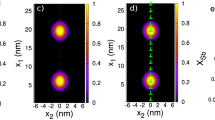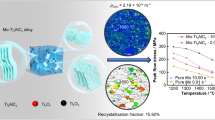The interdiffusion and microstructural evolution of the Cr2O3–Al2O3 (5 vol.% ZrO2) diffusion couple are studied in the temperature range 1600–1800°C under microwave heating (24 Hz) and, for comparison, under traditional heating using electron microprobe analysis and microscopic analysis. It is found that the concentration of chromium is distributed differently in Al2O3 in diffusion zones under microwave and traditional heating. This is due to greater contribution of grain-boundary diffusion to the effective diffusion flux under microwave heating. Bulk diffusion and average grain-boundary diffusion coefficients are calculated. The grain size in the diffusion zone toward Al2O3 is smaller after microwave heating. Traditional heating induces grain growth by recrystallization, whereas two processes, recrystallization and polygonization, are superimposed during microwave heating. The polygonization is due to the generation of dislocations under thermal stresses originating from nonuniform temperature distribution in the diffusion zone with variable concentrations of the components. The calculated bulk and grain-boundary diffusion coefficients can be used to predict the kinetics of various diffusion mass-transfer processes in Al2O3 and Cr2O3 oxides and their mixtures.










Similar content being viewed by others
References
W. H. Sutton, “Microwave processing of ceramic materials,” Ceram. Bull., 68, No. 2, 376–386 (1988).
Yu. V. Bykov, K. I. Rybakov, and V. E. Semenov, “High-temperature microwave processing of materials (topical review),” J. Phys. D: Appl. Phys., 34, R55–R75 (2001).
Yu. V. Bykov, S. V. Egorov, A. G. Eremeev, et al., “Effects of microwave heating in nanostructured ceramic materials,” Powder Metall. Met. Ceram., 49, No. 1–2, 31–41 (2010).
M. A. Janney, H. D. Kimrey, W. R. Allen, and J. O. Kiggans, “Enhanced diffusion in sapphire during microwave heating,” J. Mater. Sci., 32, 1347 (1997).
K. I. Rybakov and V. E. Semenov, “Possibility of plastic deformation of an ionic crystal due to the nonthermal influence of a high-frequency electric field,” Phys. Rev. B, 49, 64–68 (1994).
K. I. Rybakov and V. E. Semenov, “Mass transport in ionic crystals induced by the ponderomotive action of a high-frequency electric field,” Phys. Rev. B, 52, 3030–3033 (1995).
O. I. Getman, V. V. Panichkina, V. V. Holoptsev, et al., “Diffusion processes in Ba–Sr–Titanate system under microwave heating,” Key Eng. Mater., 206–213, 389–392 (2006).
O. I. Get’man, V. V. Panichkina, P. Ya. Radchenko, et al., “Diffusion processes and structurization in microwave sintering of BaTiO3–SrTiO3 and Al2O3–Cr2O3 powder systems with complete miscibility,” Powder Metall. Met. Ceram., 48, No. 5–6, 279–289 (2009).
Yu. Bykov, A. Eremeev, M. Glyavin, et al., “24-84-GHz gyrotron systems for technological microwave applications,” IEEE Trans. Plasma Sci., 32, 67–72 (2004).
SIAMS600, SIAMS Ltd, Ekaterinburg, http://siams.com.
L. J. Harrison, “Influence of dislocation on diffusion kinetics in solids with particular reference to alkali halides,” Transact. Faraday Soc., A57, No. 8, 1191–1199 (1961).
L. N. Paritskaya, Y. Kaganowskii, and V. V. Bogdanov, “Size dependent diffusion penetrability of nanomaterials,” Solid State Phenom., 94–102, 25–34 (2003).
P. G. Shewmon, Diffusion in Solids, McGraw-Hill, New York (1963).
J. C. Fisher, “Calculation of diffusion penetration curves for surface and grain boundary diffusion,” J. Appl. Phys., 22, Issue 1, 74–77 (1951).
L. N. Paritskaya, V. I. Novikov, and V. S. Kruzhanov, “Diffusional homogenization of objects from ultrafine copper and nickel powders,” Powder Metall. Met. Ceram., 21, No. 7, 554–557 (1982).
R. W. Balluffi, “Polygonization during diffusion,” J. Appl. Phys., 23, No. 10, 1407–1411 (1952).
K. Bedu-Amissah, J. M. Rickman, H. M. Chan, and M. P. Harmer, “Grain boundary diffusion of Cr in pure and Y-doped alumina,” J. Am. Ceram. Soc., 90, No. 5, 1551–1555 (2007).
E. G. Moya, F. Moya, A. Sami, et al., “Diffusion of chromium in alumina single-crystals,” Philos. Mag. A, 72, No. 4, 861–70 (1995).
V. S. Stubican and J. W. Osenbach, “Grain-boundary and lattice diffusion of 51Cr in alumina and spinel,” W. D. Kingery (ed.) Advances in Ceramics. Structure and Properties of MgO and Al 2 O 3 Ceramics, Vol. 10, The American Ceramic Society, Columbus, Ohio (1984), pp. 406–417.
B. Lesage, A. M. Huntz, and G. Petot-Ervas, “Transport phenomena in undoped and chromium or yttrium doped-alumina,” Radiat. Eff., 75, Issue 1–4, 283–299 (1983).
Author information
Authors and Affiliations
Corresponding author
Additional information
Translated from Poroshkovaya Metallurgiya, Vol. 51, No. 11–12 (488), pp. 61–74, 2012.
Rights and permissions
About this article
Cite this article
Get’man, O.I., Panichkina, V.V., Paritskaya, L.N. et al. Interdiffusion and Structural Changes in the Cr2O2–Al2O3(ZrO2) Diffusion Couple under Microwave Heating. Powder Metall Met Ceram 51, 666–676 (2013). https://doi.org/10.1007/s11106-013-9482-1
Received:
Published:
Issue Date:
DOI: https://doi.org/10.1007/s11106-013-9482-1




